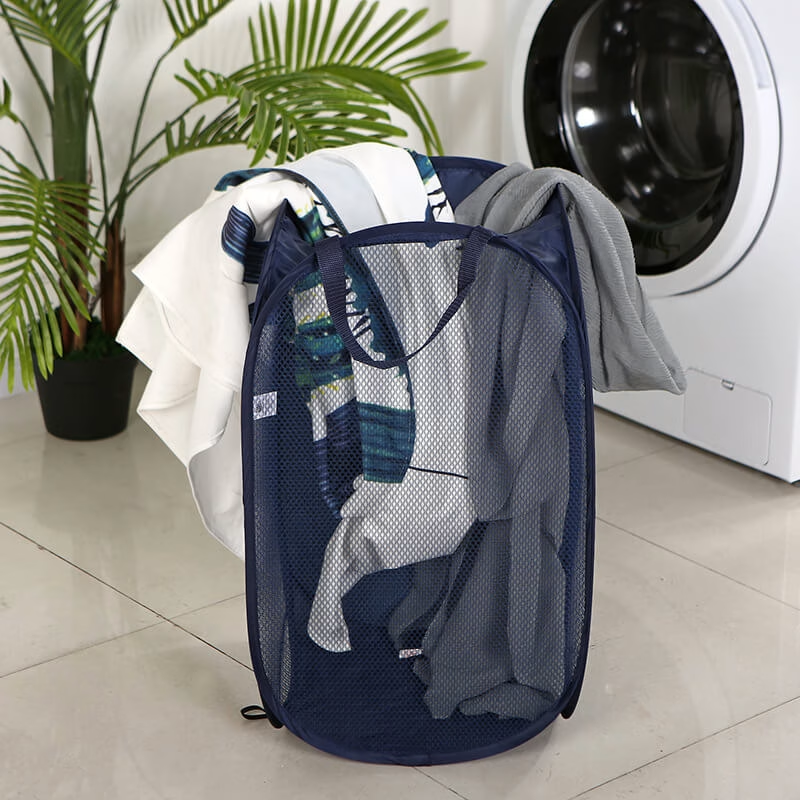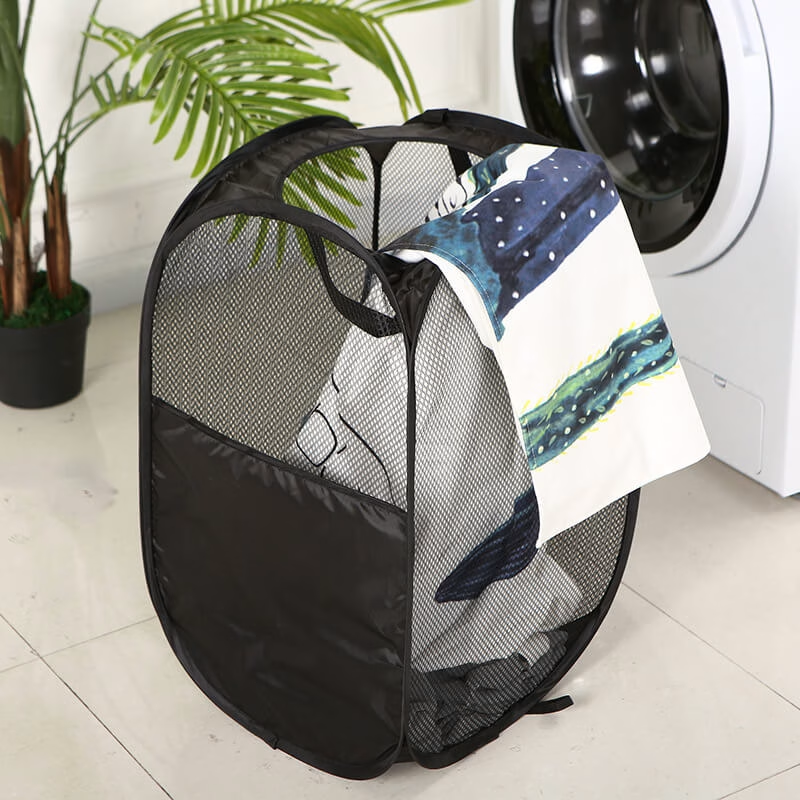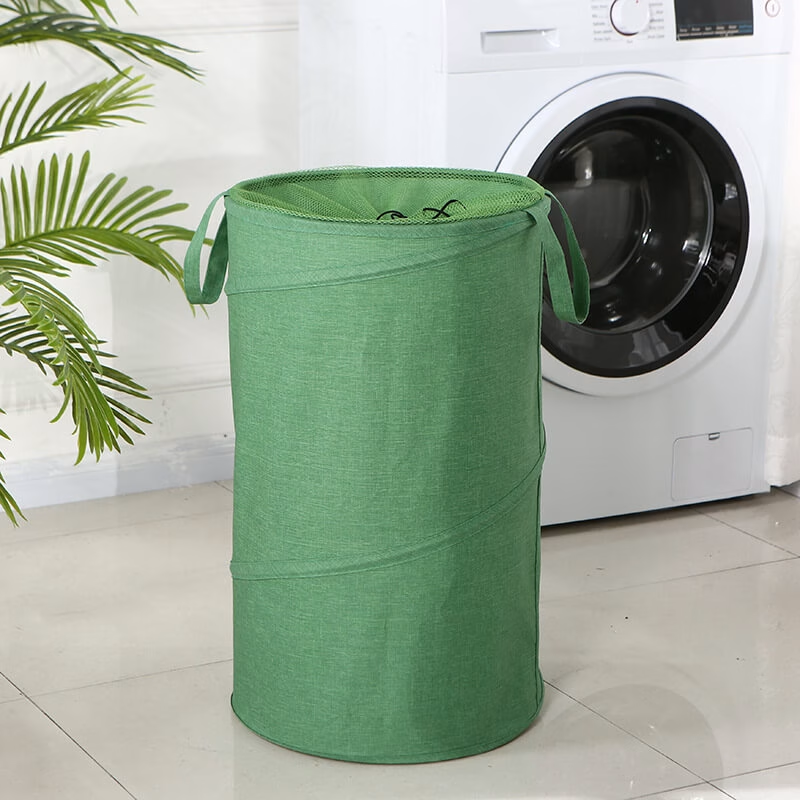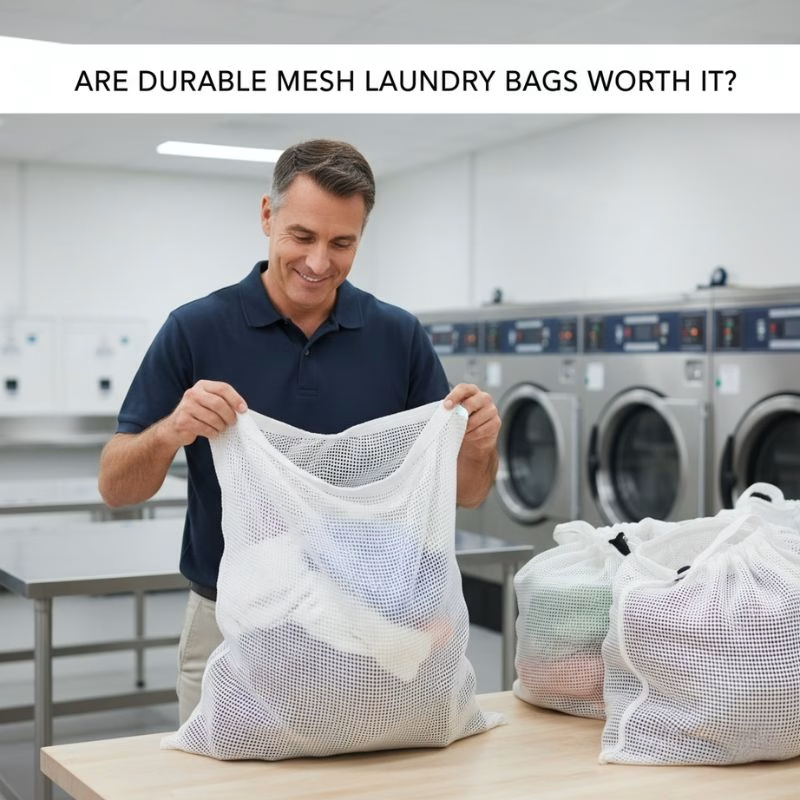Ever wondered why some laundry baskets fall apart after a few months while others last for years? The difference isn’t luck—it’s manufacturing quality. Most people assume all laundry baskets are created equal, but the reality is far more complex. The materials, construction methods, and quality control processes used by a laundry basket manufacturer directly impact durability, functionality, and customer satisfaction. If you’re sourcing laundry baskets wholesale for your business, understanding the manufacturing process helps you make smarter purchasing decisions. Let’s pull back the curtain and explore how premium mesh laundry baskets are actually made.
The Raw Materials: Where Quality Begins
Manufacturing excellence starts with material selection. Not all mesh is the same, and experienced manufacturers know this truth well.
Choosing the Right Mesh Fabric
The mesh fabric forms the heart of any quality laundry basket. Manufacturers typically use polyester mesh because it offers breathability, strength, and moisture resistance. The mesh comes in different grades based on denier count—the measure of fiber thickness. Higher denier counts mean thicker, more durable mesh.
Premium facilities source mesh with reinforced weaving patterns. This creates a fabric that resists tearing even when loaded with wet towels or heavy jeans. The mesh must also allow proper airflow to prevent mildew and odors from building up inside the basket.
Some manufacturers add UV-resistant treatments to the mesh. This matters for baskets used in sunny laundry rooms or outdoor areas. Without this protection, the fabric degrades and weakens over time.
Frame Materials and Structural Support
The frame gives the basket its shape and load-bearing capacity. Modern facilities use several frame options:
Steel wire frames provide maximum strength but add weight. Manufacturers coat these frames with vinyl or powder coating to prevent rust. The coating process requires careful temperature control to ensure even coverage.
Plastic frames offer lightweight alternatives. High-density polyethylene (HDPE) or polypropylene creates frames that resist cracking and breaking. These materials also handle humidity better than metal alternatives.
Spring steel wire creates collapsible frames for portable designs. The wire must maintain tension through repeated folding and unfolding cycles. Only specific steel grades meet this requirement.
The Manufacturing Process: Step by Step
Walking through a professional manufacturing facility reveals the careful coordination required to produce quality mesh laundry baskets.
Pattern Cutting and Fabric Preparation
The process begins with precision cutting. Computer-controlled cutting machines slice mesh fabric according to exact patterns. These patterns account for seam allowances and stress points.
Workers inspect each cut piece for defects. Any flaws in the mesh—thin spots, tears, or irregular weaving—get flagged and removed. This quality check prevents defective materials from entering the production line.
The cut pieces then move to preparation stations. Here, workers mark fold lines, attachment points, and reinforcement zones. These markings guide the assembly process and ensure consistency across all units.
Frame Assembly and Shaping
Frame construction varies by design complexity. Simple frames require basic shaping and connection. More complex designs need multiple components fitted together.
For wire frames, workers bend steel wire using specialized jigs. These jigs ensure every frame has identical dimensions. The bent frames then receive their protective coating through dipping or spraying processes.
Plastic frames start as injection-molded components. The molds determine the final shape and thickness. Manufacturers maintain these molds carefully because any wear affects product consistency. After molding, frames cool and harden before moving to assembly.
Sewing and Assembly
This stage transforms raw materials into functional products. Industrial sewing machines stitch the mesh fabric to frames using heavy-duty thread. The thread must match the mesh in strength and durability.
Skilled operators guide the mesh through sewing machines at consistent speeds. They pay special attention to stress points—bottom corners, handle attachments, and frame connection points. These areas receive double or triple stitching for added strength.
Some designs incorporate mesh pockets or dividers. These features require precise alignment during sewing. Even small misalignments create products that look uneven or function poorly.
Quality Control and Testing
Finished baskets move to inspection stations. Quality control teams examine every aspect of construction. They check for loose threads, uneven seams, frame alignment, and mesh integrity.
Load testing verifies structural strength. Inspectors fill baskets with weighted materials and observe how they perform. The baskets must hold specified weights without sagging, tearing, or frame deformation.
Manufacturers also conduct durability tests. These simulate months or years of use through repeated loading, unloading, and handling. Products that fail these tests return to the design phase for improvements.

Advanced Features and Customization
Modern facilities offer customization options that set products apart from basic designs.
Ventilation and Drainage Systems
Premium mesh laundry baskets incorporate enhanced ventilation. Manufacturers create strategic mesh panel placements that maximize airflow. This prevents moisture buildup and keeps laundry fresh.
Some designs include drainage holes in plastic bottom panels. These holes let water escape if wet items go into the basket. The holes must be large enough for drainage but small enough to contain small items.
Handle and Mobility Options
Handles transform baskets from stationary containers to portable solutions. Manufacturers reinforce handle attachment points with extra stitching or metal grommets. This prevents handles from tearing away under load.
Wheel systems add another level of functionality. Four-wheel designs require precise alignment so baskets roll smoothly. The wheels themselves must rotate freely while supporting the basket’s total weight capacity.
Wheeled laundry basket designs offer convenience for users who need to move heavy loads frequently.
Collapsible and Space-Saving Designs
Collapsible baskets meet demand for storage flexibility. These designs use spring-loaded frames that fold flat when not in use. The folding mechanism must operate smoothly through hundreds of cycles without losing tension.
Manufacturers test the fold-and-unfold process extensively. Weak points in the design become apparent during testing. Engineers then modify the frame or attachment methods to address these issues.
Comparison: Manufacturing Methods
Different manufacturing approaches create products with distinct characteristics. Understanding these differences helps buyers choose the right supplier.
| Manufacturing Method | Production Speed | Quality Consistency | Customization Ability | Cost Efficiency |
|---|---|---|---|---|
| Fully Automated | Very Fast | Excellent | Limited | High Volume Only |
| Semi-Automated | Moderate | Good | Moderate | Balanced |
| Skilled Hand Assembly | Slower | Variable | Excellent | Small to Medium Batches |
| Hybrid Approach | Fast | Very Good | Good | Most Versatile |
The hybrid approach combines automated cutting and preparation with skilled hand assembly. This method delivers consistent quality while allowing customization flexibility. Most established facilities use this model.

Wholesale Considerations: What Buyers Should Know
Sourcing laundry baskets wholesale requires attention to specific manufacturing factors.
Minimum Order Quantities and Lead Times
Manufacturers set minimum order quantities (MOQs) based on production efficiency. Lower MOQs offer flexibility but may increase per-unit costs. Higher volumes unlock better pricing but require larger upfront investments.
Lead times depend on order complexity and factory capacity. Standard designs ship faster than custom orders. Seasonal demand affects availability—expect longer lead times before peak laundry seasons.
Quality Certifications and Standards
Professional manufacturers maintain certifications that verify their quality systems. ISO 9001 certification demonstrates commitment to quality management. Other relevant certifications include product safety standards for materials and dyes.
Ask potential suppliers about their testing procedures. Reputable manufacturers willingly share test results and quality documentation. They understand that transparency builds trust with wholesale buyers.
Customization Capabilities
Custom designs let you differentiate your product line. Manufacturers with in-house design teams can develop unique features or branding elements. This includes custom mesh colors, logo printing, or specialized pocket configurations.
Browse various mesh laundry basket options to see what’s possible with modern manufacturing capabilities.
Sustainability in Manufacturing
Environmental responsibility increasingly influences manufacturing practices.
Material Recycling and Waste Reduction
Progressive facilities recycle mesh fabric scraps and rejected materials. They partner with recycling companies that process polyester waste into new products. This reduces landfill waste and lowers material costs.
Pattern optimization minimizes fabric waste during cutting. Computer algorithms arrange pattern pieces to use maximum fabric area. Even small improvements in cutting efficiency create significant waste reduction over large production runs.
Energy-Efficient Production
Modern facilities invest in energy-efficient machinery and lighting. LED lighting systems reduce electricity consumption in work areas. Newer sewing machines use less power while maintaining performance.
Some manufacturers install solar panels to offset energy usage. This investment pays off over time while reducing environmental impact.
Product Comparison: Construction Methods
Different construction approaches suit different market needs and price points.
– $
| Construction Type | Durability Rating | Weight | Collapsibility | Typical Price Range | Best Use Case |
|---|---|---|---|---|---|
| Wire Frame with Heavy Mesh | High | Heavy | No | Commercial laundries, heavy daily use | |
| Rigid Plastic Frame | Medium-High | Medium | No | $$ | Home use, moderate loads |
| Spring Steel Collapsible | Medium | Light | Yes | $ – $$ | Travel, small spaces, occasional use |
| Reinforced Multi-Layer | Very High | Medium-Heavy | Sometimes | $$$ | Professional facilities, maximum durability |
The construction method affects not just durability but also user experience. Heavy-duty options last longer but may be less convenient for elderly users or those with mobility limitations.

Innovation in Basket Design
Manufacturing facilities constantly develop new features based on customer feedback and market trends.
Smart Features and Integration
Some manufacturers experiment with weight sensors that integrate with smart home systems. These sensors track laundry loads and send notifications when baskets reach capacity. While still emerging, these features represent the future of laundry organization.
RFID tags embedded in commercial baskets help facilities track inventory and usage patterns. This technology proves valuable for hospitality businesses and large institutions.
Ergonomic Improvements
Manufacturers study how people interact with laundry baskets. This research informs handle placement, basket height, and carrying balance. Small design adjustments significantly improve user comfort.
Contoured handles reduce hand strain during carrying. Basket shapes that distribute weight evenly prevent back strain. These ergonomic considerations matter especially for facilities where staff handle baskets throughout their shifts.
The Role of Experience in Manufacturing
Six years of manufacturing experience teaches lessons that newer facilities haven’t encountered yet. Experienced manufacturers understand seasonal demand fluctuations, common failure points, and customer preferences across different markets.
This experience shows in product refinement. Long-term manufacturers continuously improve their designs based on real-world performance data. They know which materials work best in humid climates versus dry regions. They understand how usage patterns differ between European and North American markets.
Specialized drying net solutions demonstrate how manufacturers expand product lines based on customer needs and market knowledge.
Working with Manufacturers: Practical Advice
Building successful relationships with manufacturers requires clear communication and realistic expectations.
Communicating Your Requirements
Provide detailed specifications when requesting quotes. Include dimensions, color preferences, feature requirements, and packaging needs. The more specific your requirements, the more accurate the quotes you’ll receive.
Share your target market and use cases. This context helps manufacturers suggest appropriate materials and designs. A basket designed for college dormitories needs different features than one designed for luxury hotels.
Sample Evaluation
Always request samples before placing large orders. Evaluate samples for construction quality, material feel, and functionality. Test them with actual laundry loads to assess real-world performance.
Compare samples from multiple manufacturers. This reveals differences in quality that aren’t apparent from product descriptions alone. Pay attention to details like stitch quality, frame smoothness, and how the basket performs when loaded.
Building Long-Term Partnerships
The best manufacturing relationships extend beyond single transactions. Manufacturers who understand your business can suggest improvements and notify you about new developments. They become partners in your success rather than just suppliers.
Regular communication maintains these relationships. Share feedback about product performance and customer responses. This information helps manufacturers refine their products and better serve your needs.
Breathable mesh designs showcase how manufacturers develop specialized products for specific customer needs.

Quality That Lasts: Making the Right Choice
Understanding manufacturing processes empowers better purchasing decisions. Quality mesh laundry baskets result from careful material selection, skilled assembly, rigorous testing, and continuous improvement.
The manufacturing details we’ve explored aren’t just technical specifications—they’re the difference between products that satisfy customers and those that generate returns and complaints. Whether you’re placing your first wholesale order or evaluating new suppliers, this knowledge helps you identify manufacturers who prioritize quality.
As a professional manufacturer with six years of experience serving markets across Europe, North America, South America, Korea, and Japan, we’ve refined every aspect of our production process. Our facility produces laundry bags, washing bags, laundry baskets, storage boxes, and dirty clothes baskets with consistent quality that meets international standards.
We welcome OEM orders and offer customized designs that match your specific requirements. Contact us directly through laundrymeshbag.com to discuss your needs, request samples, or place an order. When you work with the original manufacturer, you eliminate middlemen, reduce costs, and gain a partner invested in your success.
Frequently Asked Questions
Q: What’s the typical minimum order quantity for wholesale laundry baskets?
A: MOQs vary by manufacturer and product complexity, but typically range from 500 to 2,000 units for standard designs. Custom orders often require higher minimums—usually 1,000 to 3,000 units—because they involve tooling or pattern modifications. Some manufacturers offer lower MOQs for sample runs or test markets, though per-unit pricing increases. When evaluating suppliers, discuss your volume needs upfront to find manufacturers whose MOQ structure aligns with your business model.
Q: How long does production take from order placement to delivery?
A: Standard production runs typically take 30-45 days from confirmed order to factory departure. Custom designs add 1-2 weeks for sample approval and production setup. Shipping time depends on your location and method—sea freight adds 2-6 weeks while air freight delivers in 7-15 days. Peak seasons (spring and fall) may extend lead times by 1-2 weeks. Experienced manufacturers provide realistic timelines and update you throughout production.
Q: What certifications should I look for in a laundry basket manufacturer?
A: ISO 9001 certification demonstrates quality management system compliance. For products sold in specific markets, look for relevant safety certifications—CE marking for Europe, CPSC compliance for the US if applicable. Material certifications verify that fabrics and coatings meet safety standards for consumer products. Reputable manufacturers maintain current certifications and provide documentation upon request. They also conduct regular testing for load capacity, durability, and material safety.





